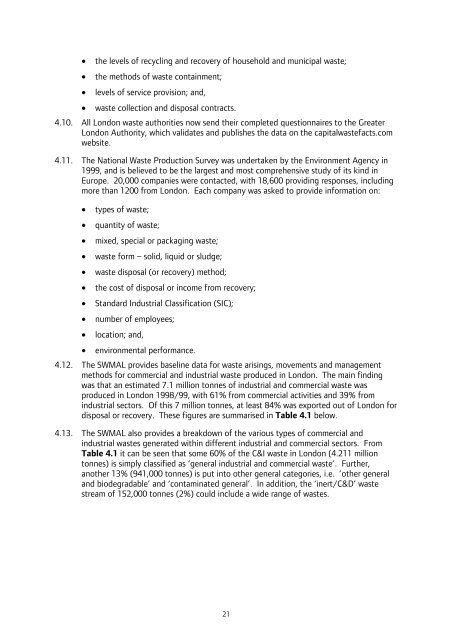London Wider Waste Strategy - London - Greater London Authority
London Wider Waste Strategy - London - Greater London Authority
London Wider Waste Strategy - London - Greater London Authority
You also want an ePaper? Increase the reach of your titles
YUMPU automatically turns print PDFs into web optimized ePapers that Google loves.
• the levels of recycling and recovery of household and municipal waste;<br />
• the methods of waste containment;<br />
• levels of service provision; and,<br />
• waste collection and disposal contracts.<br />
4.10. All <strong>London</strong> waste authorities now send their completed questionnaires to the <strong>Greater</strong><br />
<strong>London</strong> <strong>Authority</strong>, which validates and publishes the data on the capitalwastefacts.com<br />
website.<br />
4.11. The National <strong>Waste</strong> Production Survey was undertaken by the Environment Agency in<br />
1999, and is believed to be the largest and most comprehensive study of its kind in<br />
Europe. 20,000 companies were contacted, with 18,600 providing responses, including<br />
more than 1200 from <strong>London</strong>. Each company was asked to provide information on:<br />
• types of waste;<br />
• quantity of waste;<br />
• mixed, special or packaging waste;<br />
• waste form – solid, liquid or sludge;<br />
• waste disposal (or recovery) method;<br />
• the cost of disposal or income from recovery;<br />
• Standard Industrial Classification (SIC);<br />
• number of employees;<br />
• location; and,<br />
• environmental performance.<br />
4.12. The SWMAL provides baseline data for waste arisings, movements and management<br />
methods for commercial and industrial waste produced in <strong>London</strong>. The main finding<br />
was that an estimated 7.1 million tonnes of industrial and commercial waste was<br />
produced in <strong>London</strong> 1998/99, with 61% from commercial activities and 39% from<br />
industrial sectors. Of this 7 million tonnes, at least 84% was exported out of <strong>London</strong> for<br />
disposal or recovery. These figures are summarised in Table 4.1 below.<br />
4.13. The SWMAL also provides a breakdown of the various types of commercial and<br />
industrial wastes generated within different industrial and commercial sectors. From<br />
Table 4.1 it can be seen that some 60% of the C&I waste in <strong>London</strong> (4.211 million<br />
tonnes) is simply classified as ‘general industrial and commercial waste’. Further,<br />
another 13% (941,000 tonnes) is put into other general categories, i.e. ’other general<br />
and biodegradable’ and ‘contaminated general’. In addition, the ‘inert/C&D’ waste<br />
stream of 152,000 tonnes (2%) could include a wide range of wastes.<br />
21
















